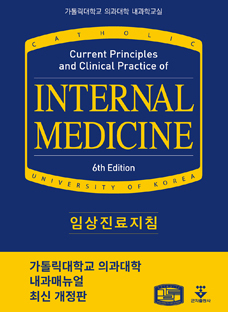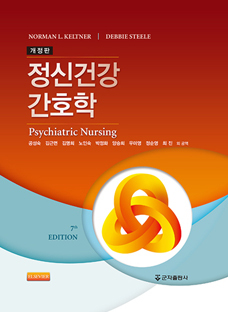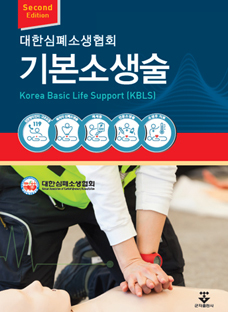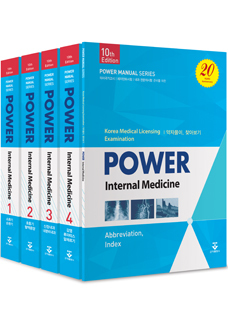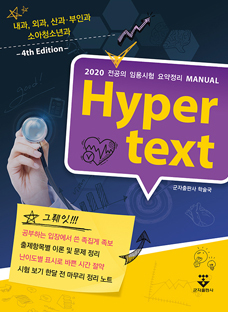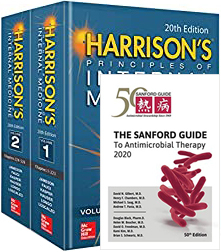Family Medicine Handbook,The,5/e
저자
University of Iowa
출판사
Mosby
의학
정가
66,000원 판매가
66,000원 적립금
1,000원
발행일
20060502
페이지수
1008
ISBN10
0323039499
배송비
결제금액이 25,000원 이상 무료배송
주문수량
바로 구매하기
장바구니 담기
관심도서 등록
Dex_scription Written by experts at the University of Iowa, this popular resource contains all of the up-to-date clinical information you need to diagnose and treat disorders commonly seen in inpatient and ambulatory settings. bulleted text, tables, and algorithms enable you to grasp what you need to know in moments. You’ll also find a new two-color design, making it easier to find the facts you need—when you need them. Plus, BONUS handheld software lets you access the entire contents of the book as well as a drug index and calculators, anywhere and anytime you want.
Key Features
Hands on information that is truly germane to patient management. CDC guidelines on post-exposure HIV prophylaxis and hepatitis C diagnosis and treatment. Treatment options beyond standard guidelines, for assistance when the usual protocols fail. New to this Edition
Includes BONUS handheld software, containing the entire contents of the book as well as a drug index and calculators. Provides evidence-based guidelines and number needed to treat (NNT) and number needed to harm (NNH) when available. Features an expanded herbal formulary, highlighting drug-herb interactions and the evaluation of the effectiveness of herbal therapies. Offers new information on SARS and West Nile virus. Incorporates a new section on Long-Term Care. Discusses clotting and platelet disorders and the evaluation of serum total protein in an expanded hematology section. Offers additional adult immunization information. Uses a new two-color design, making it easier to find the facts you need—fast.
Resuscitation, Airway Management, And Acute Arrhythmias 1. Airway Management And Rapid Sequence Intubation 2. Critical Cardiac Life Support 3. Specific Rhythms And Their Treatment 4. Critical Pediatric Life Support 5. Critical Neonatal Resuscitation Emergency Medicine 1. The Management Of Acute Chest Pain In The Emergency Department Setting 2. Seizures 3. Asthma/COPD/Dyspnea 4. Coma 5. Head Trauma 6. Trauma 7. Hypertensive Crisis 8. Aortic Dissection (Thoracic) 9. Abdominal Aortic Aneurysm 10. Shock 11. Overdose and Toxidromes 12. Bites 13. Environmental Illness and Burns 14. Burns, Cold, and Thermal injury 15. Rhabdomyolysis Cardiology 1. Acute Coronary Syndromes 2. Cardiac Arrhythmias 3. Valvular Heart Disease 4. Congestive Heart Failure 5. Hypertension 6. Syncope 7. Dyslipidemias 8. Prophylaxis Against Bacterial Endocarditis Pulmonary Medicine 1. Pulmonary Embolism And Deep Venous Thrombosis 2. Pulmonary Function Tests 3. Ventilators and Oxygen Therapy 4. Chronic Obstructive Pulmonary Disease (COPD) 5. Asthma 6. Bronchiectasis 7. Pneumonia 8. Hypersensitivity Pneumonitis 9. Viral Respiratory Tract Infections 10. Evaluation Of The Chronic Cough 11. Obstructive Sleep Apnea 12. Sarcoidosis 13. Wegener`s Granulomatosis 14. Hemoptysis/Pulmonary Hemorrhage 15. Pleural Effusion Gastroenterology And Hepatology 1. Dyspepsia (see Gastroesophageal Reflux Disease) 2. Peptic Ulcer Disease 3. Esophageal Diseases 4. Acute Diarrhea 5. Chronic Diarrhea 6. Traveler`s Diarrhea 7. Celiac Sprue (Gluten-Sensitive Enteropathy) 8. Lactose Intolerance 9. Irritable Bowel Syndrome 10. Clostridium Difficile Infection 11. Giardiasis 12. Diverticular Disease 13. Inflammatory Bowel Disease 14. Bacterial Overgrowth Syndromes 15. Anorectal Diseases 16. Gastrointestinal Bleeding 17. Differential Diagnosis of Elevated Liver Enzymes 18. Viral Hepatitis 19. Ascites and Spontaneous Bacterial Peritonitis 20. Alcoholic Liver Disease, Liver Failure, and Chronic Liver Disease 21. Hepatic Encephalopathy 22. Acute Pancreatitis Hematologic, Electrolyte, and Metabolic Disorders 1. Bleeding Disorders : Split 2. Clotting Factor Disorders 3. Platelet Disorders 4. Managing Anticoagulation 5. Anemia 6. Sickle Cell Anemia 7. Glucose-6-Phosphate Dehydrogenase (G6PD) deficiency 8. Iron-Storage Diseases 9. Transfusion Medicine: Available Products And Transfusion Reactions 10. Evaluation of Elevated Serum Total Protein 11. Potassium 12. Sodium 13. Calcium 14. Magnesium 15. Glucose 16. Hyperthyroidism 17. Thyroid Storm 18. Hypothyroidism 19. Myxedema Coma 20. Thyroid Enlargement 21. Adrenal Disease 22. Acid-Based Disorders Rheumatology 1. Rheumatology: General 2. Rheumatoid Arthritis 3. Osteoarthritis 4. Crystal-Induced Synovitis 5. Spondyloarthropathies 6. Septic Arthritis 7. Rheumatic Fever And Rheumatic Carditis 8. Fibromyalgia Syndrome 9. Chronic Fatigue Syndrome 10. Polymyalgia Rheumatica And Giant Cell Arteritis 11. Raynaud`s Phenomenon 12. Systemic Lupus Erythematosus 13. Drug-Induced Lupus 14. Antiphospholipid Syndrome 15. Systemic Sclerosis And Scleroderma Nephrology and Urology 1. Urinary Tract Infections: Females 2. Urinary Tract Infection: Children 3. Lower Urogenital Infections: Male 4. Upper Urinary Tract Infection: Males And Females 5. Sexually Transmitted Diseases 6. Benign Prostatic Hypertrophy 7. Hematuria 8. Urolithiasis 9. Acute Scrotal Pain And Scrotal Masses 10. Urinary Incontinence 11. Penile Problems 12. Erectile Dysfunction 13. Renal Failure 14. Chronic Renal Failure 15. Proteinuria, Nephrotic Syndrome, And Nephritic Urine 16. Glomerulonephritis And Nephritis Neurology 1. Headache 2. Dementia 3. Delirium 4. Seizures 5. Parkinson`s Disease 6. Benign Nocturnal Leg Cramps 7. Restless Leg Syndrome 8. CNS Infection 9. Cerebrovascular Disease 10. Neuropathy 11. Multiple Sclerosis 12. Vertigo and Dizziness Infectious Disease 1. Principles Of Culturing 2. Infestations 3. Tuberculosis 4. Immunosuppressed Host 5. Sepsis 6. Fever Of Unknown Origin 7. Lyme Disease 8. Ehrlichiosis 9. Babesiosis 10. Leptospirosis 11. Rocky Mountain Spotted Fever 12. Bacterial Endocarditis 13. Malaria 14. West Nile Virus 15. SARS 16. Bioterrorism: Presentations, incubation periods, important numbers and websites for further information 17. Adult Immunizations HIV/AIDS 1. Definition and Transmission of HIV/AIDS 2. Postexposure Prophylaxis Resources and Registries 3. AIDS by Organ System 4. How to Diagnose HIV Infection 5. Initial Evaluation of the HIV-Positive Patient 6. Natural History 7. Management of HIV Infection 8. Infections in AIDS Patients 9. AIDS-Associated Weight Loss and Wasting 10. Neuropsychiatric Disease 11. Dermatologic Manifestations 12. Pregnancy in AIDS Pediatrics 1. Newborn Nursery 2. Neonatal Jaundice 3. Respiratory Disorders In The Newborn 4. Neonatal Infections 5. Congenital Infections 6. Neonatal Hematologic Disorders 7. Neonatal Metabolic Disorders 8. Neonatal Gastrointestinal Disorders 9. Feeding And Supplementations 10. Pediatric Wellness 11. Short Stature 12. Crying And Colic 13. Safety And Accident Prevention 14. Infections 15. Vomiting, Diarrhea, And Dehydration 16. Constipation And Encopresis 17. GI Bleeding In Childhood 18. Stridor And Dyspnea 19. Limp And Joint Pain 20. Nocturnal Enuresis Gynecology 1. Contraceptives 2. Vaginal, Vulvar, And Related Conditions 3. Pelvic Inflammatory Disease (PID) 4. Bartholin`s Glands 5. Abnormal Vaginal Bleeding, Menstrual Problems, And Secondary Amenorrhea 6. Endometrial Abnormalities 7. Dysmenorrhea 8. Premenstrual Syndrome (PMS) 9. Chronic Pelvic Pain 10. Polycystic Ovarian Syndrome (PCOS) 11. Abnormal Pap Smears 12. Infertility 13. Endometriosis 14. Adnexal Masses 15. Pediatric Gynecology 16. Menopause 17. Sexual Assault 18. Osteoporosis 19. Ectopic Pregnancy Obstetrics 1. Preconception Care 2. Prenatal Care 3. Prenatal Patient Education 4. RH Screening And Rho(D) Immunoglobulin 5. Prenatal Diagnosis Of Congenital Disorders 6. Alpha-Fetoprotein (AFP) Triple Screen 7. Antenatal Fetal Surveillance 8. Group B Streptococcal (GBS) Infection 9. Nausea And Vomiting Of Pregnancy 10. Diabetes In Pregnancy: Gestational Diabetes Mellitus (GDM) 11. Trauma And Pregnancy 12. Hypertension In Pregnancy, Preeclampsia, And Eclampsia 13. Early Antepartum Hemorrhage 14. Late Antepartum Hemorrhage 15. Intrauterine Growth Retardation (IUGR) 16. Labor 17. Amnioinfusion 18. Obstetric Anesthesia And Analgesia 19. Vaginal Delivery 20. Breech Delivery 21. Episiotomy 22. Shoulder Dystocia 23. Cesarean Section 24. Postpartum Hemorrhage 25. Postpartum Care 26. Puerperal Fever General Surgery 1. Wound Management 2. Preoperative Cardiac Risk Assessment 3. Preoperative Pulmonary Evaluation 4. Preoperative Laboratory Evaluation 5. Preoperative Management Of Anticoagulation 6. Preoperative Care and Evaluation 7. Postoperative Care 8. Postoperative DVT Prophylaxis 9. Abdominal Pain 10. Appendicitis 11. Gallbladder Disease 12. Intestinal Obstruction Orthopedics 1. Low Back Pain 2. Shoulder Pain 3. Elbow 4. Wrist And Hand 5. Hip: Bursitis Of The Hip 6. Knee Pain 7. Ankle Sprain 8. Heel Pain: Plantar Fasciitis 9. Foot Pain 10. Rotational Deformities Of The Lower Extremity 11. Fractures Dermatology 1. Pruritus 2. Skin Infections 3. Acne 4. Papulosquamous Disease 5. Vesiculobullous Lesions 6. White Lesions 7. Other Dermatitides 8. Urticaria Psychiatry 1. Mood Disorders 2. Anxiety Disorders 3. Substance-Use Disorders 4. Acute Psychosis 5. Schizophrenia And Other Psychotic Disorders 6. Eating Disorders 7. Attention Deficit Disorder 8. Personality Disorders Ophthalmology 1. Eye Examination 2. The Red Eye 3. Trauma 4. Orbit, Eyelids, And Lacrimal Apparatus 5. Cornea And Lens 6. Retina 7. Optic Nerve And Visual Pathway Otolaryngology 1. Hearing Loss 2. Trauma 3. Nasal Trauma 4. Ear Pathology 5. Facial Nerve Paralysis 6. Nose 7. Tongue And Mouth 8. Throat 9. Temporomandibular Joint Care of the Elderly Patient 1. Cognitive impairment 2. Gait and balance disorders 3. Immobility 4. Pressure ulcers 5. Polypharmacy 6. Sensory impairment 7. Pain 8. Falls Office/Hospital Procedures 1. Tympanometry 2. Chest Tube Placement 3. Intraosseous Infusion 4. Regional Blocks 5. Central Venous Lines 6. Thoracentesis 7. Nasal Foreign Body Removal Herbal Formulary 1. Unsafe Herbal Preparations 2. Herbal Formulary 3. Dangerous Herbal product-drug interactions Rapid References 1. Pediatric Sedation 2. Pediatric Vital Signs 3. Pediatric Growth and Development 4. Pediatric Laboratory Results 5. Competitive Sports Recommendations 6. Peak Flow Rates 7. Dermatomes 8. Immunizations 9. Metabolic Formulas 10. Electrolyte Formulas Endsheets: 1. Adult Preventive Care Timeline 2. Child Preventive Care Timeline
더보기
배송안내
당일출고
List
구분
13시 이전
13시 이후
군자도서
당일출고
1일 추가
타사도서
1일 ~ 2일 추가
2일 ~ 3일 추가
고객님께서 급히 필요하신 상품은 별도로 나누어 주문하시면 수령시간이 절약됩니다.
- 당일 13시 이전에 주문과 결제가 확인된 주문건에 대해서 당일출고를 진행합니다.
(단, 타사도서, 원서 제외되며 군자출판사에서 출간된 도서로 이뤄진 주문건에 한합니다.)
- 월요일 ~ 금요일 사이에 출고가 진행되며, 토요일과 일요일, 연휴기간에는 배송업무가 없으므로 구매에 참고 바랍니다.
- 도서수령일의 경우 제품이 출고된 후 하루에서 이틀정도 추가되며, 배송시간은 안내가 어렵습니다.
해외원서의 경우
국내에서 재고를 보유한 업체가 없는 경우 해외주문을 해야 하는 상황이 생깁니다.
배송비 안내
- 25,000원 이상 구매시 무료배송 (결제금액이 25,000원 미만일 경우 2,500원의 배송료가 자동으로 추가됩니다.
- 반품/취소.환불 시 배송비는 최소 무료 배송이 되었을 경우, 처음 발생한 배송비까지 소급 적용될 수 있으며, 상품 하자로 인한 도서 교환시에는 무료로 가능합니다.
반품안내
전자상거래에 의한 소비자보호에 관한 법률에 의거 반품 가능 기간내에는 반품을 요청하실 수 있습니다.
반품가능기간
- 단순변심 : 물품 수령 후 14일 이내 (단, 고객님의 요청으로 주문된 해외원서 제외)
교환이나 반품, 환불이 가능한 경우
- 주문하신 것과 다른 상품을 받으신 경우
- 파본인 상품을 받으신 경우
- 배송과정에서 손상된 상품을 받으신 경우
교환이나 반품, 환불이 불가능한 경우
- 개봉된 DVD, CD-ROM, 카세트테이프 (단, 배송 중 파손된 상품 제외)
- 탐독의 흔적이 있는 경우
- 소비자의 실수로 상품이 훼손된 경우
- 고객님의 주문으로 수입된 해외 도서인 경우
- 수령일로 14일 지난 상품의 경우
반품절차
3일 이내에 알려주세요.
- 책을 받으신 3일 이내에 고객센터 031-943-1888 혹은 1:1 문의게시판을 통해 반품의사를 알려주세요.
- 도서명과 환불 계좌를 알려주시면 빠른 처리 가능합니다.
- 도서는 택배 또는 등기우편으로 보내주시기 바랍니다.
참고
- 14일 이내에 교환/반품/환불 받으실 상품이 회수되어야 하며, 반품과 환불의 경우 상품주문시 면제받으셨던 배송비와 반품배송비까지 고객님께서 부담하시게 됩니다.
반품주소
(10881) 경기도 파주시 회동길 338 (서패동 474-1) 군자출판사빌딩 4층
환불방법
- 카드결제 시 카드 승인취소절차를 밟게 되며 무통장입금시 현금 환불 혹은 적립금으로 변환 가능합니다.
- 반품도서와 함께 주문번호와 환불계좌번호를 알려주시면 빠른 처리 가능합니다.
비밀번호 입력
글 작성시 입력한 비밀번호를 입력하세요.
상품문의 작성
해당상품에 대해 궁금한 사항을 문의해 주세요.
